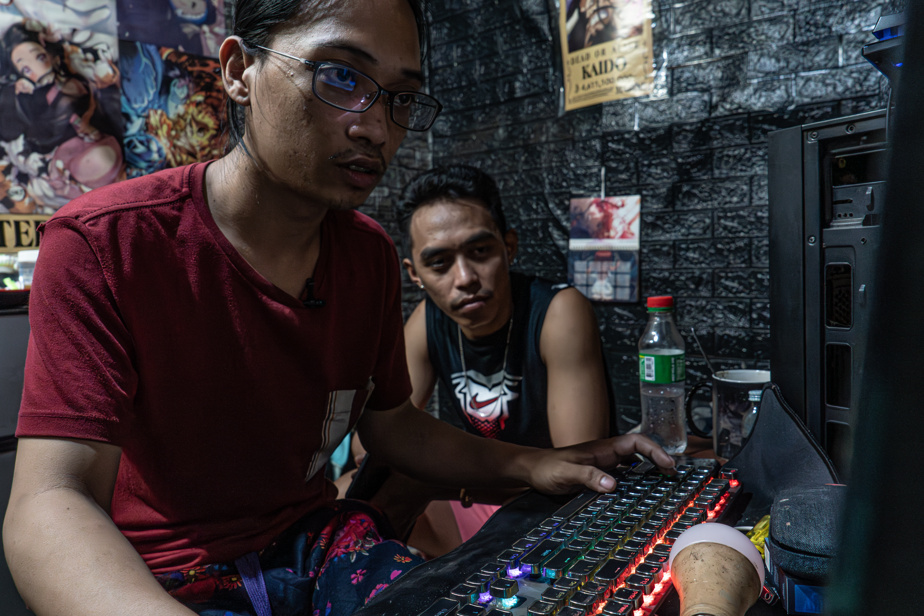(Cagayán de Oro) Like every evening, the internet café in the slum of Cagayan de Oro, a large city in the south of the Philippines, is packed. Slouching in front of their computer, two teenagers play a video game. Behind them, three children scroll through videos on TikTok. A little further on, a little girl is passionate about a Japanese cartoon.
Through the window, the moonlight bathes the neighborhood in metallic light. The door to the internet café suddenly opens with a creak.
“Come on, everyone goes to bed, the adults have to work,” two men bark as they burst into the overheated den. After vain protests, the children disperse like a flock of sparrows.
Junbee and John-Henry, aged 22 and 27, each take a position in front of a screen. “We don’t have enough money to buy a personal computer, so we come to work here every night, from 8 a.m. to 5 a.m. During the day, there are too many children, we can’t concentrate,” one of them explains in a tired voice.

PHOTO THÉOPHILE SIMON, SPECIAL COLLABORATION
A large city in the south of the Philippines, Cagayan de Oro has become a breeding ground for cheap workers for artificial intelligence giants.
Their screens soon display amateur photos full of food: asparagus risotto served in a Western restaurant; a Christmas log immortalized on New Year’s Eve; a cappuccino placed on the counter of a trendy café; fried eggs and toast at the lunch table.
With expert hands, Junbee and John-Henry surround each food item using their mouse.
Our job is to analyze thousands of food photos taken around the world. We cut out the outline of each food before identifying it in software. By repeating this task thousands of times, we teach artificial intelligence to recognize objects on its own.
John-Henry, 27 years old
“This technology is already integrated into iPhones, which are now capable of recognizing objects photographed by their owners,” reveals John-Henry, clicking on a photo of hard-boiled eggs placed next to cereal bars.
The two budding computer scientists will repeat this task around fifty times during the night, for a salary of around $6 Canadian. “It’s less than the legal minimum and I have no social protection, but I have no choice. In this corner of the Philippines, there are very few jobs,” says Junbee. “The other solution is to sell drugs. However, I want a future,” agrees John-Henry, one of whose parents has just been sentenced to several years in prison for drug trafficking.
Autonomous cars
Junbee and John-Henry are not the only ones who spend their nights training artificial intelligence algorithms. Along the streets lined with tin houses, dozens of other residents of the neighborhood carry out similar tasks.

PHOTO THÉOPHILE SIMON, SPECIAL COLLABORATION
Cheiro works 12 hours a day, every day of the week.
From a tiny windowless room, eyes glued to an old screen, Cheiro, 27, examines a cloud of thousands of points scattered across a three-dimensional plane. Juxtaposing the whole thing with a photo taken from the dashboard of a car driving in San Francisco, he selects certain clusters of points using his mouse, then notes their geometric coordinates in software.
Each of these points materializes the bounce of the laser projected by the autonomous car as it analyzes its environment. I have to identify each shape to help the vehicle distinguish another car from a pedestrian, a tree from a sign, or an animal from a building. I repeat this task for about twelve hours a day, seven days a week, often at night.
Cheiro, 27 years old
“If I understand correctly, this data will one day allow artificial intelligence to replace drivers,” he says, pointing to a corner of the room where a smelly bench lies on a wooden pallet.

PHOTO THÉOPHILE SIMON, SPECIAL COLLABORATION
A Remotasks employee, in her village on the outskirts of Cagayan de Oro
A logo located to the left of its screen betrays the identity of the employer of these artificial intelligence (AI) convicts: Remotasks, a subsidiary of the young American startup ScaleAI. Founded in 2016 in San Francisco by Alexandr Wang, a genius from MIT then just 19 years old, the company specializes in providing data to world leaders in AI. A juicy vein: during its last fundraising, in 2021, ScaleAI was valued at nearly 10 billion Canadian dollars. The company’s clients include Apple, Google, OpenAI, Samsung, Lexus, Hyundai, Amazon and the US military.
In order to train their algorithms, champions of Silicon Valley and other multinationals lured by the promises of AI need immense quantities of “annotated” data, that is to say previously deciphered and organized by humans. The ocean of photos captured by Apple or Samsung mobile phones is thus examined; the content of millions of hours of video filmed by Google’s self-driving cars is listed; millions of accounting documents are dissected in order to one day be able to automate the administrative services of thousands of companies.
“Alexandr Wang often says that artificial intelligence is like a child. At the beginning, she needs adults to point out and explain the world to her before becoming independent. This is the mission that ScaleAI has set itself,” says Bayani*, a former Remotasks executive met in Cagayan de Oro.
* Fictitious first name to preserve the anonymity of the former Remotasks executive
